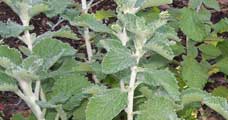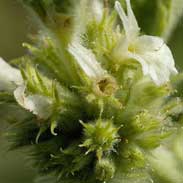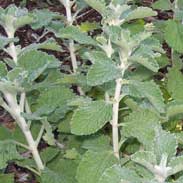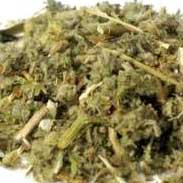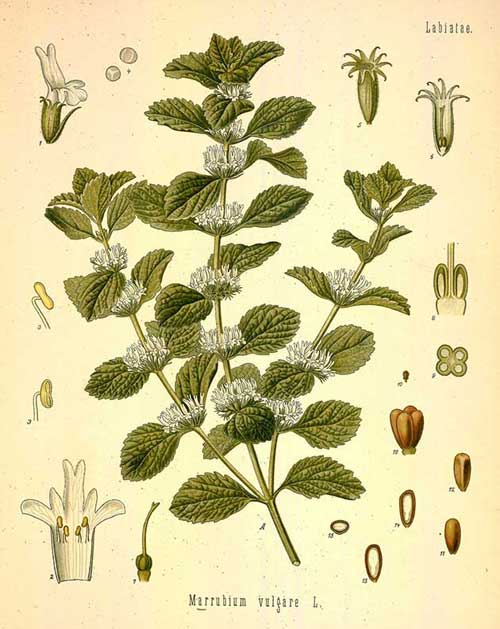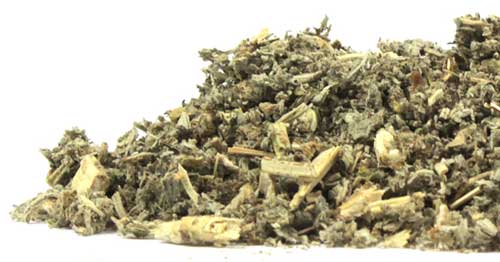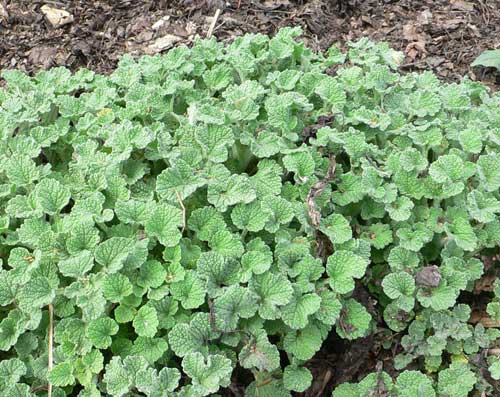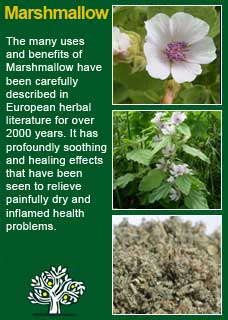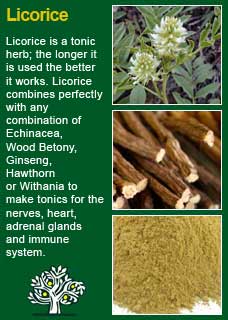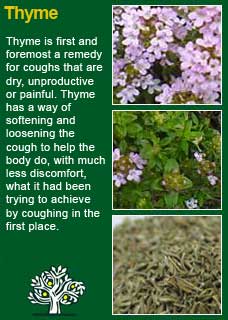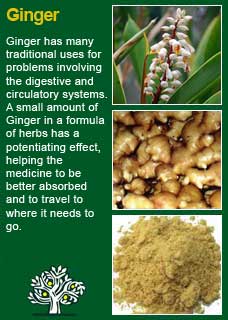
|
|
||||
| Our Pages ABOUT CONSTITUTIONAL MEDICINE
|
In herbal medicine the parts we use are the flowering tops and the short, corrugated leaves that are densely covered in a white downy ‘fur’. White horehound is a ow growing, long lived herb which has an unusual, persistent and distinctly bitter taste that is rather unpalatable to animals, hence it thrives in hilly pastureland!
White Horehound has been highly regarded as a cleansing lung tonic for millennia. It has especially been used for bronchitis, whooping cough, chesty colds and loss of voice. It is known as what is called a ‘stimulating expectorant’ which means that it both increases the production and the release of mucus and phlegm from the lungs and bronchial tubes. The Roman physician Galen highly recommended Horehound for coughs and respiratory problems. German Abbess/Herbalist St Hildegard thought it was one of the best remedies for colds. The great English herbalist John Gerard wrote "Horehound is a most singular remedy against coughs and wheezings of the lungs'. Culpeper wrote about White Horehound that it is a 'remedy for those who are short-winded, have a cough, or are fallen into consumption, it helpeth to expel phlgem from the chest'. White Horehound has additional properties of stimulating the liver (most bitter herbs have an element of this going on) and it was historically recommended for ‘yellowing of the eyes’; i.e. the signs of a congested liver. H Felter writes 'White Horehound is a stimulating expectorant and tonic, and is adapted to both acute and chronic irritation of the larynx and bronchial tract, and gives added power to respiration. In small doses it is a gastric tonic of considerable value, but given too freely it will act as an emetic and cathartic. A hot infusion is diaphoretic; a cold infusion, diuretic. Horehound, usually in the form of a syrup, is useful in hoarseness, coughs, and colds that do not clear up rapidly, chronic bronchial catarrh, and humid asthma' TJ Lyle writes 'White Horehound is a gently diffusive, stimulating tonic to the respiratory organs. One of the most popular of herbal lung remedies. Exceedingly valuable in coughs, colds and pulmonary affections. In hot infusion it is somewhat diaphoretic, promotes a good outward flow of the circulation and relieves conditions of the lungs associated with congestions and hoarseness. In combination with Leonurus (Motherwort) it relieves the menstrual flow. Its best influence upon the lungs is in combination with Inula (Elecampane) and Prunus (Wild Cherry bark) White Horehound decreases the mucous discharge and gives good results in wet catarrh and where expectoration is too free' King's Dispensatory writes White horehound is a stimulant tonic, expectorant, and diuretic. Its stimulant action upon the laryngeal and bronchial mucous membranes is pronounced and it, undoubtedly also influences the respiratory function. It is used in coughs, colds, chronic catarrh, asthma, and all pulmonary affections. The British Herbal Pharmacopoeia (BHP) describes the actions of White Horehound as 'expectorant & spasmolytic' and says it is indicated for 'acute or chronic bronchitis and whooping cough' and specifically indicated for 'bronchitis non-productive cough'. The BHP recommends a dose of 1-2 grams or by infusion (a rather heaped tsp is about 1.2-1.4 grams) Thomas Bartram writes that the actions of White Horehound include 'stimulating expectorant, mild antiseptic, antispasmodic, sedative, vulnerary, diuretic, stomach & liver bitter tonic'. He suggests uses for it including 'chronic bronchitis, whooping cough, hard cough with little phlegm, common cold, loss of voice, snake bite, dog bite, chronic gall bladder disease, fevers, malaria, hepatitis, 'yellowness of the eyes'. Bartram recommends a tea from 1 tsp to each cup of boiling water, infuse 15 minutes, dose half to 1 cup as needed, or 1-2 mls of the liquid extract of White Horehound. John Heinerman writes 'nothing breaks up severe mucus congestion quite like Horehound. In fact, I've found it to work a lot better than even coltsfoot! (a remarkably potent lung herb but also rather a dangerous one). One cup of warm horehound tea will instantly loosen impacted phlegm in the throat, lungs and sinuses like you wouldn't believe and relieves a great deal of the misery attending a sinus headache'.
~ There have been no clinical trials with people taking White Horehound but there has nevertheless still been some intriguing research into this old herbal remedy. It has been shown to contain a bitter diterpene molecule called marrubiin which Russian and German studies has demonstrated to possess expectorant properties, i.e. it loosens catarrh in the chest and helps it to be expelled. ~ The authors, titles and the 'where-and-when' published of over 50 further studies and articles on White horehound are listed in a PDF found here
For some years now, against this proven and safe way of herbalism, there has been a rising tide of excessive caution and scare-mongering in many parts of the world. The same authorities that, not so long ago, decried herbal medicines as ineffectual, have now taken up a different adversarial position; that they are dangerous substances that should only be prescribed by Doctors, who of course have zero training in them. Unfortunately, the same unnecessary fear and worry has crept into many natural health websites and popular publications on herbs. Herbs that we have safely used for thousands of years, that have no reports of adverse reactions in the medical literature despite widespread use by millions of people, are suddenly described as contraindicated because of something that should have been seen as completely unimportant, or at the utmost a merely theoretical concern, such as a laboratory study on one of the herb's constituents to use an all too common example. I wonder sometimes if the writers of such articles feel that the herb will be more deserving of respect if it is thought to be a little bit dangerous, in other words more like a drug than something that has simply come out of the earth and been used by ordinary people for generations beyond count. There is just so much misinformation about herbal medicine on the internet now. Ludicrous claims and cautions abound in equal measure; it seems like one group are trying to make money out of the public whilst the other are busily trying to scare them off. I have to believe that the kind of reader who takes the time to read pages on herbs that are as extensive as this one is much less likely to be swayed by marketers or misinformers. I hope that you will keep your wits about you if you get conflicting opinions from people who have never really got to know these herbs, who have never worked with them, or learned how to use them safely and effectively. I want to remind you that the reason that herbs can never be patented and owned by any individual or corporation is because they are, and always will be, the People's medicine. They belong to all of us and it is my great hope in sharing this work that you will learn how to use them wisely for yourself, and the people you care for. Be safe, but do not be afraid.
I have found White Horehound to be especially effective for people with chronic obstructive respiratory conditions and I could hardly imagine treating difficult and chronic conditions such as asthma, bronchitis and recurrent chest infections without its help. If someone has a tendency to a weak chest then the younger you start them with White horehound the better. It can be tremendous at helping to strengthen the lungs and get clear of congestion but there is a real art to balancing its bitterness in a formula so that the patient will tolerate and take the medicine for the time needed to affect the cure. If you who are reading this are studying herbal medicine or if you have your own reasons to want to understand this plant ally at a much deeper level then I urge you to get some White Horehound tea or tincture and then, with a quiet and attentive mind, take some and observe for yourself how it makes you feel. This ancient method of experiential learning can give you insights that no amount of academic study can achieve. Further to this, if you would like to learn more about the ancient art of pulse testing, a simple but powerful way to ask the intuitive intelligence of the body for its responses to a herb by feeling the pulse whilst giving a tiny dose by mouth, read here Speaking for myself I find it quite uncanny just how much I can feel White Horehound in my own chest when I take some with a quiet mind. I would encourage anyone using it for the first time to feel for themselves just how much it makes them want to breathe deeper and clear their lungs. First of all you are likely to get some very real respect for just how strong a tasting medicine this is and how careful you have to be to get the dose right, not too little and certainly not too much. Stay with the experiment and feel for yourself how the herb gets into your chest and you may get a sense yourself of how it is as determined as a snow-plough when it comes to helping move debris out of the airways! White Horehound starts working right away and will keep exerting a positive influence for as long as it is needed and as long as it is taken. In other words, its effects will not wear off if used over a longer time-frame, quite the contrary. Some examples of how I use it in practice are written up in my article on asthma here and the page on bronchitis and pneumonia here For many different kinds of lung weakness or respiratory diseases White horehound combines perfectly with such herbs as Mullein, Elecampane, Aniseed, Thyme, Marshmallow, Licorice root, Golden Rod, Lobelia and Wild Cherry bark. It is a great herb to add to a formula to give it some respiratory punch!
Much of the information here about the traditional uses of White horehound is consistent with the model of thinking whereby one may treat problem A with herb B. There is value in this approach in how it helps us pass on useful knowledge to one another but where it falls short is that people are not all cut from the same cloth! White horehound might work brilliantly for one person but less well for another -- why is this? Part of the reason is that people vary in their constitutions as to whether they are either hotter or cooler and, at the same time, either dryer or damper. This useful and rather fascinating subject is introduced further here Another big part of using the right herb when it is most needed comes from understanding the need to treat what is going wrong for the person that had led up to their getting a health condition. In this light, White horehound can particularly offer its benefits when a cleansing action is needed in the 'cycle of healing', more about this here
Please understand that I cannot advise you, including on products or dosage, without seeing you in person in my clinic but for ideas
on how you might find a good herbalist in your area read here |
|
|
|
© 2011 R.J.Whelan Ltd
